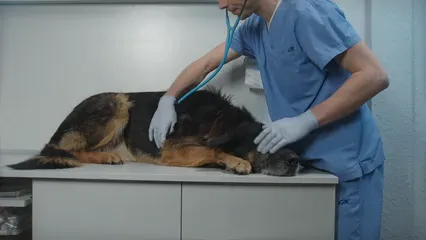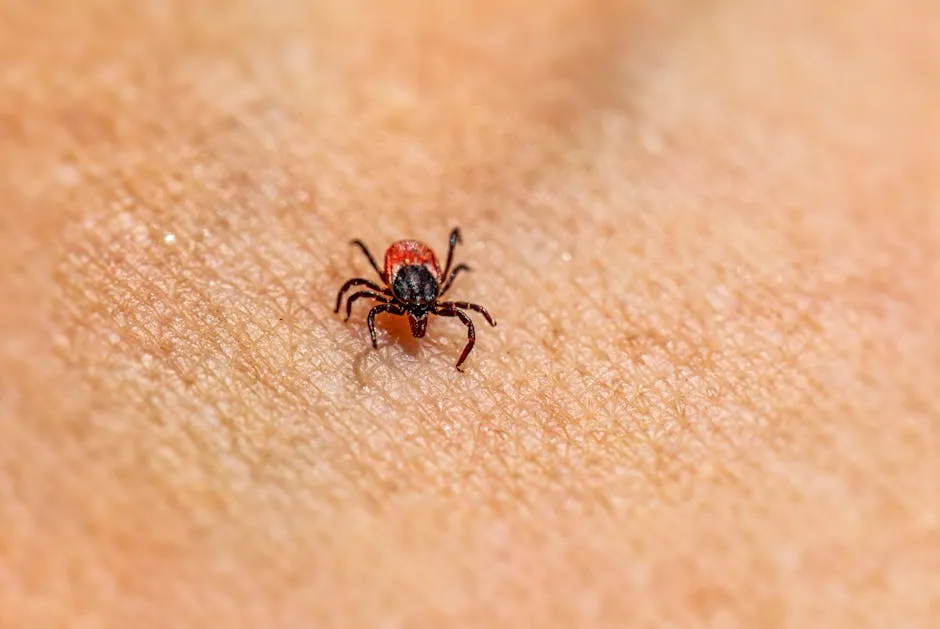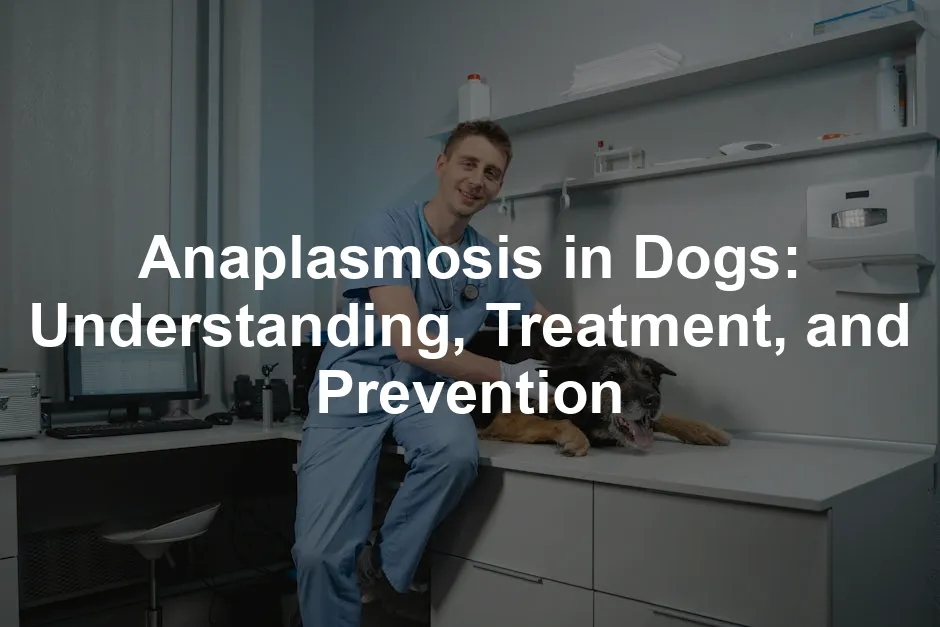Introduction
Anaplasmosis is a serious tick-borne disease affecting dogs. It’s essential for dog owners to understand this condition. Anaplasmosis can lead to severe health issues if not treated promptly. In this article, we’ll cover symptoms, diagnosis, treatment options, and prevention strategies for this disease.
And while you’re at it, make sure you have the right tools in your pet care arsenal. A Tick Removal Tool Kit is essential for quick and safe removal of ticks from your furry friend. Trust me, your dog will thank you for it!
Summary and Overview
Anaplasmosis is caused by two primary agents: Anaplasma phagocytophilum and Anaplasma platys. The former infects white blood cells, while the latter affects platelets. This disease is prevalent across the globe, particularly in the United States, where it poses a significant risk to canine health.
Infections are most common in the Northeast, upper Midwest, and coastal states. If left untreated, anaplasmosis can lead to long-term health issues. It’s crucial to recognize its relationship with other tick-borne diseases, like Lyme disease. Awareness and preventive measures are vital in protecting our furry friends.

Speaking of prevention, keeping your dog protected from fleas and ticks is imperative. Consider using Frontline Plus Flea and Tick Treatment. It’s a trusted choice for dog owners and can save your pup from those pesky parasites.
Understanding Anaplasmosis
What is Anaplasmosis?
Anaplasmosis is a bacterial infection transmitted by ticks. The primary tick species involved include the deer tick and the brown dog tick. These ticks thrive in grassy, wooded, and humid environments.
Infection rates are highest in spring and early summer. Anaplasma phagocytophilum is more common in northern regions, while Anaplasma platys is prevalent in southern areas. According to studies, infection rates are rising, especially in areas with high tick populations. Regularly checking your dog for ticks after outdoor activities is essential for prevention.

And what better way to keep your dog entertained while you check for ticks than with an Interactive Dog Puzzle Toy? It keeps their minds sharp and gives you peace of mind!
Symptoms of Anaplasmosis
Symptoms can vary based on the strain of Anaplasma. Common symptoms include lethargy, fever, and joint pain. Dogs may also show signs of loss of appetite and lameness. Less common symptoms can include vomiting and respiratory issues.
Dogs infected with Anaplasma platys may exhibit bleeding disorders, such as nosebleeds or bruising. Symptoms typically manifest within one to two weeks following a tick bite. If you notice any concerning signs, seek veterinary care immediately. Early intervention is crucial for a successful recovery.

To be prepared for any emergencies, having a Dog First Aid Kit on hand is a great idea! You never know when you might need it, and your dog will appreciate your preparedness.
Diagnosis of Anaplasmosis
Diagnosing anaplasmosis can be complex due to overlapping symptoms with other diseases. A thorough history and physical examination are essential. If your dog shows signs like lethargy or joint pain, consult a veterinarian for a proper evaluation.
Common diagnostic tests include ELISA (enzyme-linked immunosorbent assay) and PCR (polymerase chain reaction). These tests help detect the presence of Anaplasma bacteria in your dog’s system. However, the sensitivity and specificity can vary. For instance, ELISA tests have a sensitivity of around 85%, while PCR tests offer higher accuracy.
Despite these advancements, diagnosing anaplasmosis can still pose challenges. Symptoms may mimic those of Lyme disease or other tick-borne illnesses. This overlap can lead to misdiagnosis or delayed treatment. If you suspect your dog has been exposed, prompt veterinary consultation is crucial. Early diagnosis can lead to better outcomes and quicker recovery for your furry friend.

Treatment Options for Anaplasmosis
Treatment for anaplasmosis typically involves antibiotics, with doxycycline being the preferred choice. This medication is effective against both Anaplasma phagocytophilum and Anaplasma platys. The standard treatment duration ranges from 14 to 30 days, depending on your dog’s condition.
If you need a reliable source for this medication, remember that Doxycycline Antibiotics are available, but remember, a prescription is required!
Most dogs begin to show improvement within 24 to 48 hours after starting antibiotics. However, it’s vital to complete the entire course, even if your dog appears better. Stopping treatment prematurely could lead to a relapse or lingering infection.

Prevention of Anaplasmosis
Preventing anaplasmosis involves proactive measures to control tick exposure. Using veterinarian-recommended tick prevention products is crucial. Options include topical treatments, collars, and oral medications. These products can help keep ticks off your dog, significantly reducing the risk of infection.
For instance, the Seresto Flea and Tick Collar for Dogs is a fantastic option for long-lasting protection!

Additionally, check your dog regularly for ticks, especially after outdoor activities. Focus on areas like between toes, under the collar, and around ears. If you find a tick, remove it carefully with tweezers, gripping close to the skin.
Environmental management also plays a role in prevention. Keep your yard well-maintained by mowing grass and trimming bushes. This reduces tick habitats and lowers the risk of your dog coming into contact with infected ticks. For personalized prevention plans, schedule a consultation with your veterinarian to ensure your dog remains safe from anaplasmosis and other tick-borne diseases.
Zoonotic Potential of Anaplasmosis
Anaplasmosis is caused by Anaplasma, which can affect both dogs and humans. While direct transmission from dogs to people is rare, the risk still exists. Ticks carry this pathogen, making tick management essential for pet owners. To protect yourself and your furry friend, implement effective tick prevention methods during tick season.
If you’re planning a trip and want to keep your dog safe, consider a Dog Travel Bag. It makes packing for your pup a breeze, ensuring you have everything you need on your journey!

Regularly check your dog for ticks after outdoor activities, especially in grassy or wooded areas. Consider using veterinarian-recommended tick prevention products for added safety. By taking these precautions, you minimize the risk of zoonotic diseases, ensuring better health for both you and your pet. Stay informed about these risks to keep your loved ones safe.
Conclusion
Awareness and prevention are crucial when dealing with anaplasmosis in dogs. This tick-borne disease can lead to severe health issues if left untreated. Regular veterinary check-ups are essential to catch any early signs of illness. Taking proactive measures, like using tick prevention products, can help protect your furry companion.
Additionally, a Dog First Aid Book can be a lifesaver in emergencies, providing you with essential knowledge to help your dog in critical situations.
Understanding the risks associated with tick-borne diseases is vital for pet owners. By staying informed, you can take the necessary steps to ensure your dog’s health and well-being. Don’t hesitate to consult your veterinarian for guidance on effective prevention strategies.
FAQs
What are the main symptoms of anaplasmosis in dogs?
Anaplasmosis in dogs can display various symptoms. Common signs include lethargy, fever, and joint pain. Dogs may also lose their appetite or show lameness. Some less typical symptoms involve vomiting and respiratory issues. If you notice any of these signs, it’s crucial to consult your veterinarian promptly.
How is anaplasmosis diagnosed in dogs?
Diagnosing anaplasmosis often involves a thorough veterinary examination. Your vet will likely recommend specific tests like ELISA or PCR to confirm the diagnosis. A detailed history of your dog’s health and tick exposure will help in making an accurate diagnosis. Timely testing is essential for effective treatment.
What is the treatment for anaplasmosis in dogs?
Treatment for anaplasmosis usually consists of antibiotics, predominantly doxycycline. This treatment typically lasts between 14 to 30 days. Most dogs begin to show improvement within 24 to 48 hours after starting the medication. Completing the full course is crucial to prevent relapse.
Can humans get anaplasmosis from dogs?
Anaplasmosis is a zoonotic disease, meaning it can potentially infect humans. However, direct transmission from dogs to humans is rare. The primary concern is exposure to infected ticks. Therefore, maintaining strict tick control measures is vital for both pets and owners.
How can I prevent my dog from contracting anaplasmosis?
Preventing anaplasmosis involves effective tick control. Use veterinarian-recommended tick prevention products year-round. Regularly check your dog for ticks, especially after outdoor activities. It’s essential to remove any ticks found promptly, as they need to feed for at least 24 hours to transmit the disease.
Please let us know what you think about our content by leaving a comment down below!
And if your dog loves the outdoors, a Dog Life Jacket can keep them safe during water activities!
Thank you for reading till here 🙂
If your dog is experiencing joint pain, consider exploring the best supplements for dogs with joint pain and arthritis to help alleviate their discomfort.
All images from Pexels





